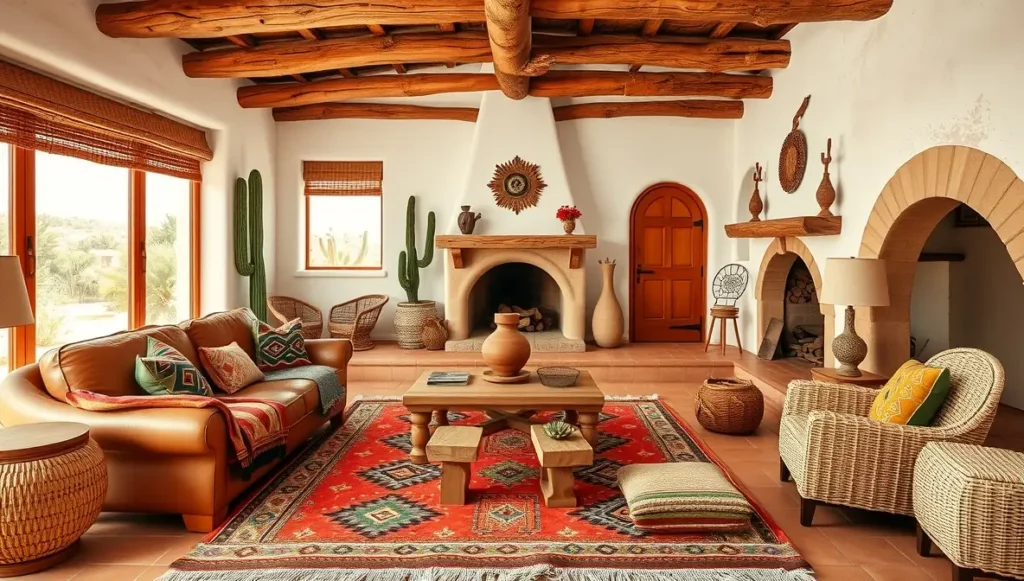- Bauhaus Interior Design: Why This 100-Year-Old Style Still Works Today - September 6, 2025
- Southwestern Interior Design: What I Wish I’d Known 20 Years Ago - September 6, 2025
- Why Norwegian Interior Design Actually Makes Your Home Feel Like Home - September 4, 2025
Table of Contents
Look, I’ve been designing homes in the Southwest since 2003, and I’m going to tell you something that might surprise you: most “Southwestern” rooms I see look like someone ransacked a tourist gift shop in Sedona. That’s not what this style is about.
I learned this the hard way during my third year in business. Had this client in Santa Fe who wanted her whole house redone in “authentic Southwestern style.” I went overboard, cacti everywhere, cow skulls on every wall, enough turquoise to stock a jewelry store. When her 89-year-old neighbor (whose family had lived in the area since the 1800s) came over for coffee, she took one look around and said, “Honey, this looks like where tourists think we live.”
That comment changed everything for me.
Where This Style Really Comes From
Real Southwestern design happened because three different groups of people figured out how to live comfortably in the desert. Each brought something essential:
The Native Americans were here first, obviously. They knew which materials worked, which colors made sense, how to stay cool when it’s 115 degrees outside. Their geometric patterns came from the landscape itself, the mesa shapes, river patterns, the way shadows fall across desert floor.
Spanish colonists showed up with Mediterranean building ideas that somehow worked perfectly in New Mexico and Arizona. They brought us those thick adobe walls and red tile roofs. Mixed with Native techniques, you got something completely new.
Mexican craftspeople added the warmth and artistry. Without their incredible textiles, metalwork, and ceramics, Southwestern rooms would feel pretty sterile. They’re the ones who made it beautiful, not just functional.
Colors That Don’t Suck
Here’s where everyone screws up: they think desert = brown. Wrong.
Go sit outside in Tucson at sunset. Or drive through Monument Valley in October. The desert has incredible color, you just have to pay attention!
Your main colors should come from the actual landscape. That warm terracotta you see in canyon walls (not the bright orange stuff from Home Depot). The soft green of desert sage. That perfect dusty pink that sandstone turns in certain light. These colors make rooms feel calm without being boring.
For accents, look at desert flowers and minerals. Real turquoise of the deep, complex kind Native American jewelers use, not that electric blue tourist crap. The orange-red of barrel cactus blooms. Deep wine red from prickly pear flowers. Use these sparingly. A little goes a long way.
Your neutrals aren’t beige. They’re the fifty different shades of sand you see on one desert hike. Cream like early morning light. Rich camel like wet earth after a rare rainstorm. These create depth that flat contractor beige never will.
I came across this living room in Santa Fe that captured the desert palette beautifully – a soft sage green sofa-set against warm sand-colored walls, with just a few orange-red accents that made the whole space glow. It felt effortless, grounded, and completely true to the Southwest.
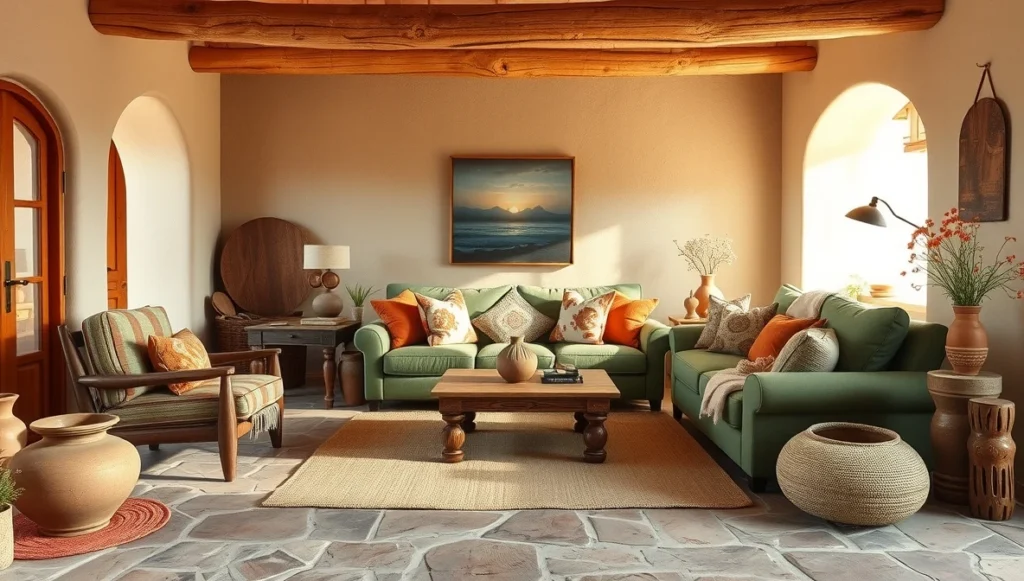
Materials That Actually Matter
I can spot fake Southwestern design from my car. It’s usually the materials that give it away.
If you’re lucky enough to have real adobe walls, don’t mess with them. Those imperfections and hand-troweled bumps are worth more than any perfect drywall job. For everyone else, good venetian plaster can get you close, but find someone who actually knows what they’re doing.
Wood should look like it has stories. I hate seeing perfectly sanded vigas (those ceiling beams) that look like they came from a factory. The point is that weathered, been-here-forever appearance. Pine and cedar age beautifully. Let them.
Textiles need personality. You want pieces that look like they came from someone’s grandmother’s chest, not a coordinated bedroom set. Navajo patterns, authentic Mexican blankets, hand-woven rugs with slight irregularities, that’s what gives rooms soul.
Stone and tile work separates the real from the fake every time. Saltillo tiles are handmade, so no two look identical. That’s the point. Natural stone brings in actual desert colors. Hand-painted Mexican ceramics add character. The machine-made “southwestern style” tiles from big box stores fool nobody who knows what they’re looking at.
What I’ve Figured Out Room by Room
Living Rooms Where People Actually Want to Hang Out
Start with one great leather sofa. Cognac or deep brown, something that’ll look better in ten years than it does today. Add some chairs in textured fabric, sage linen works great, or maybe terracotta cotton if the light is right. Built-in bancos under windows give you extra seating that feels authentic, not like you bought it at a chain store.
You need a focal point that doesn’t scream “look at me.” Kiva fireplaces are incredible if you can swing the construction. Otherwise, a substantial wooden mantel with some wrought iron details does the job without trying too hard.
Coffee tables should feel permanent. Thick wood with visible grain, maybe some live edge if you can find the right piece. I love vintage equipal furniture when I can track it down, those Mexican leather and wood pieces add character without being obvious about it.

Kitchens That Work for Real Life
Southwestern kitchens have to balance charm with actually being able to cook in them. I’ve gotten pretty good at this balance.
For cabinets, you want wood that looks substantial. Knotty alder if your budget allows, pine if it doesn’t. Reclaimed wood is even better, it comes with history built in. Hardware should be oil-rubbed bronze or wrought iron, nothing too shiny or new-looking.
Your backsplash is where you get to show off. I don’t care what the budget is, handmade tiles aren’t optional. Mix saltillo with some decorative painted pieces. The slight imperfections and color variations are what make it look real instead of manufactured.
Countertops need to handle desert living. Natural stone in warm tones ages beautifully. I’ve also done hand-troweled concrete tinted with desert colors. Develops this gorgeous patina over time.
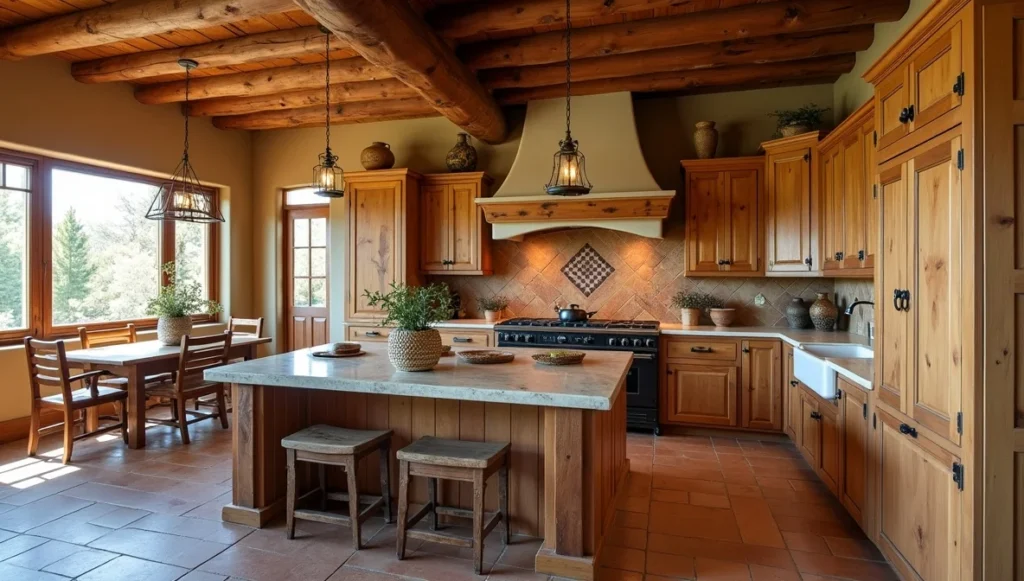
Bedrooms That Feel Like Desert Retreats
Bedrooms should feel like sleeping under stars, peaceful and connected to the landscape, but still comfortable enough for real life.
Bed frames in wrought iron or rustic wood with character marks. Keep bedding simple – white sheets always work. Layer warmth with woven blankets in burgundy, turquoise, warm orange. Vintage Pendleton blankets are perfect if you can find them.
Walls make or break the mood. Hand-troweled plaster in soft sand colors creates this incredible soothing backdrop. Sometimes one accent wall in deeper terracotta works, but be careful not to make the room feel closed in. Reclaimed wood behind headboards adds texture without overwhelming.
Furniture should be simple but built to last. Rustic wooden dressers with wrought iron pulls give you storage while keeping the style consistent. A comfortable leather chair in the corner that actually gets used for reading, not just decoration.
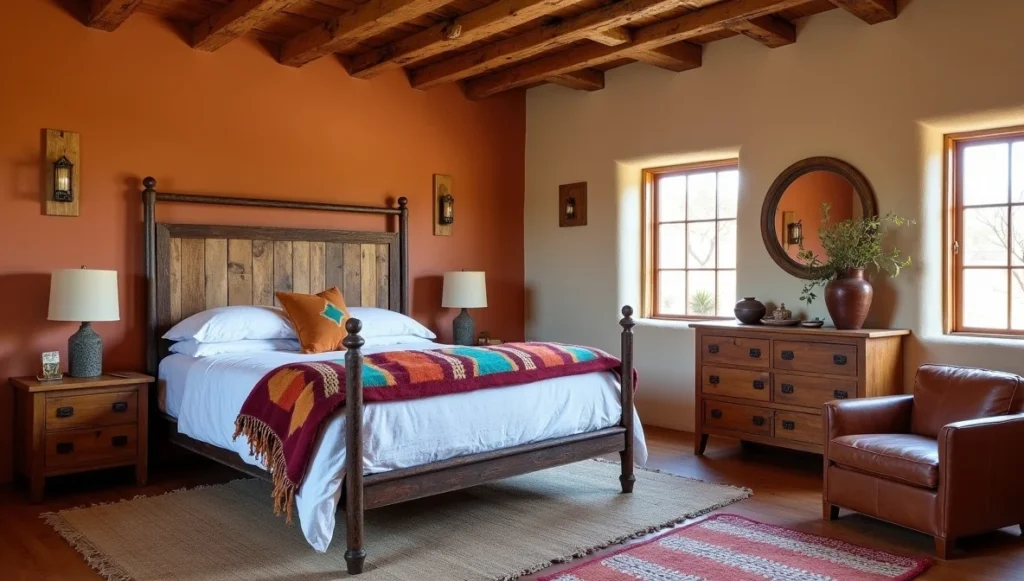
Bathrooms Like Desert Spas
Bathrooms should feel like you’re at some expensive resort in Scottsdale – warm, natural, luxurious without being flashy.
Tile work is everything here. Large natural stone on floors, smaller mosaics for accents. Hand-painted Mexican tiles around mirrors or as trim strips add personality without going overboard. The trick is knowing when to stop.
Vanities in rustic wood with vessel sinks hit that sweet spot between practical and stylish. Copper or ceramic bowls work great. I design a lot of custom pieces using reclaimed wood, it gives you exactly what fits the space while supporting the authentic feel.
Lighting has to be warm and soft. Wrought iron fixtures or pottery pieces create beautiful diffused light. Mirrors with rustic frames complete the look without trying too hard.
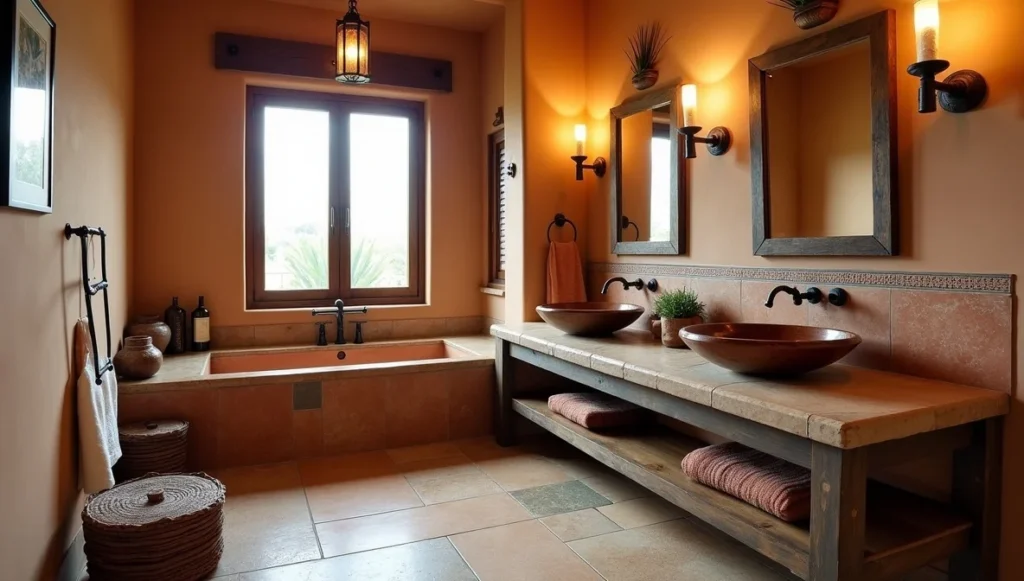
Dining Rooms for Real Gatherings
Dining tables should be the star, the big, solid wood, something that looks like it could tell stories. I hunt for pieces that show their grain and character.
Mix your seating. Some upholstered chairs, wooden benches, maybe an equipal chair if you can find one. The variety makes it feel collected over decades, not bought in one shopping trip.
Lighting sets evening moods. Wrought iron chandeliers or pottery pendants create warm ambiance while casting interesting shadows on walls. Position them to light the table without creating glare.
Storage doubles as display. Rustic hutches give you dish space while showing off pottery, baskets, or other pieces that actually mean something to you.

Home Offices with Character
Even workspaces can embrace the style without sacrificing function. Solid wood desks with wrought iron details look handcrafted, not corporate. Leather chairs in rich brown keep you comfortable through long work sessions.
Built-in shelving with natural wood or wrought iron brackets keeps things organized. Woven baskets make storage attractive instead of utilitarian.
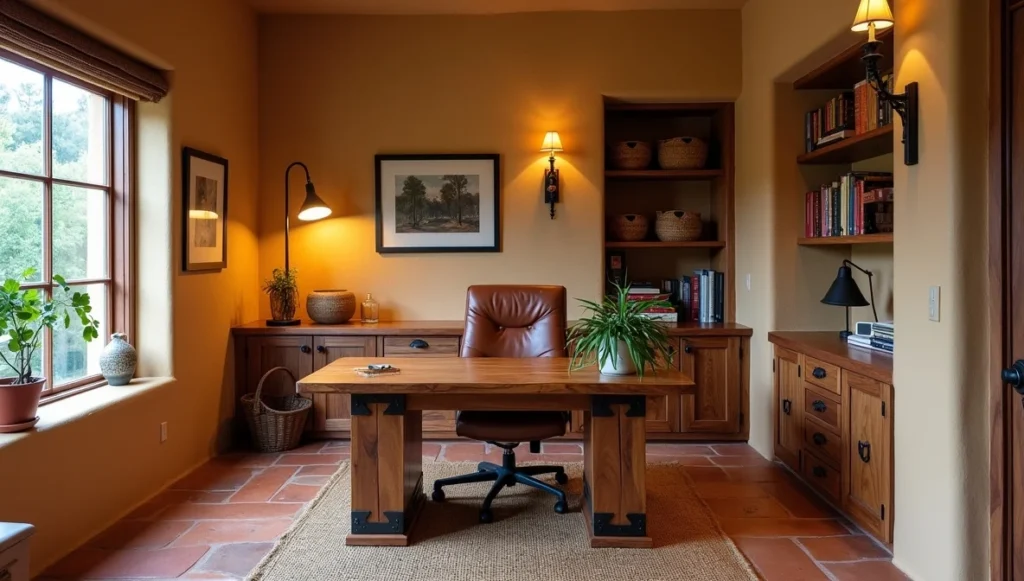
Where People Go Wrong
Three mistakes I see constantly:
Tourist trap syndrome: Every cactus decoration and cow skull you can find crammed into one space. Real style shows restraint. Authentic pieces matter more than quantity.
The matching mistake: Complete furniture sets bought all at once. This style developed over generations, the rooms should look like pieces were collected over time, not ordered from one catalog.
Climate ignorance: Heavy fabrics and dark colors that make no practical sense in desert environments. Work with your climate, not against it.
Making It Work Anywhere
You don’t need to live in Phoenix to pull this off. I’ve helped people in Florida, Colorado, even Maine create beautiful desert-inspired spaces. The secret is understanding principles instead of copying details.
Focus on natural materials when possible. Choose warm, earthy colors that work with your specific light. Look for handcrafted pieces with personality rather than perfect mass-produced items. You’re creating that sense of groundedness and connection to nature that makes Southwestern spaces special.
The best rooms I’ve designed don’t announce themselves. They whisper their style through smart choices and respect for the traditions behind the look. It’s never about checking boxes or following rules. It’s about understanding what makes desert living comfortable, then translating that feeling to wherever you happen to call home.
